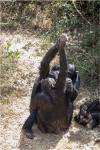Chimpanzees communicate to coordinate a cultural practice
- PMID: 36651045
- PMCID: PMC9845976
- DOI: 10.1098/rspb.2022.1754
Chimpanzees communicate to coordinate a cultural practice
Abstract
Human culture thrives by virtue of communication, yet whether communication plays an influential role in the cultural lives of other animals remains understudied. Here, we investigated whether chimpanzees use communication to engage in a cultural practice by analysing grooming handclasp (GHC) interactions-a socio-cultural behaviour requiring interindividual coordination for successful execution. Previous accounts attributed GHC initiations to behavioural shaping, whereby the initiator physically moulds the partner's arm into the desired GHC posture. Using frame-by-frame analysis and matched-control methodology, we find that chimpanzees do not only shape their partner's posture (22%), but also use gestural communication to initiate GHC (44%), which requires an active and synchronized response from the partner. Moreover, in a third (34%) of the GHC initiations, the requisite coordination was achieved by seemingly effortless synchrony. Lastly, using a longitudinal approach, we find that for GHC initiations, communication occurs more frequently than shaping in experienced dyads and less in mother-offspring dyads. These findings are consistent with ontogenetic ritualization, thereby reflecting first documentation of chimpanzees communicating to coordinate a cultural practice. We conclude that chimpanzees show interactional flexibility in the socio-cultural domain, opening the possibility that the interplay between communication and culture is rooted in our deep evolutionary history.
Keywords: Pan troglodytes; communication; coordination; culture; grooming handclasp.
Conflict of interest statement
We declare we have no competing interests.
Figures




References
-
- Enfield NJ, Levinson SC. 2006. Roots of human sociality: culture, cognition and interaction. London, UK: Routledge.
-
- Tomasello M. 2010. Origins of human communication. Boston, MA: MIT Press.
-
- Boyd R, Richerson PJ. 1985. Culture and the evolutionary process. Chicago, IL: University of Chicago Press.
-
- Gergely G, Csibra G. 2005. The social construction of the cultural mind: imitative learning as a mechanism of human pedagogy. Interact Stud. 6, 463-481. (10.1075/is.6.3.10ger) - DOI
-
- McGrew WC. 1998. Culture in nonhuman primates? Annu. Rev. Anthropol. 27, 301-328. (10.1146/annurev.anthro.27.1.301) - DOI
Publication types
MeSH terms
Associated data
LinkOut - more resources
Full Text Sources
